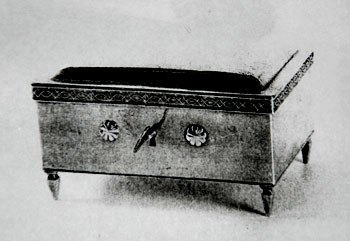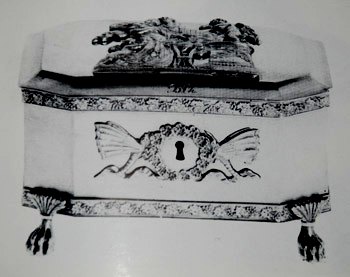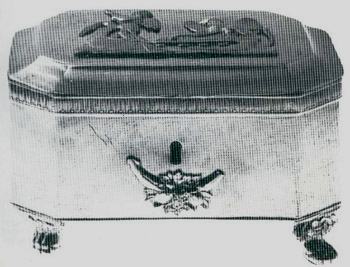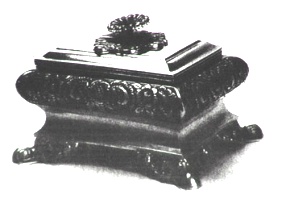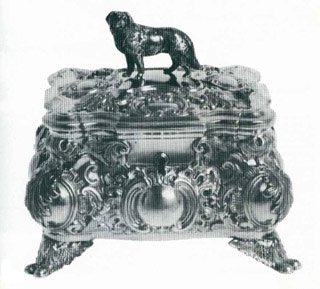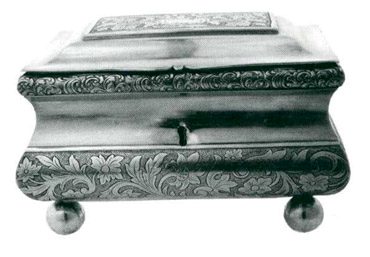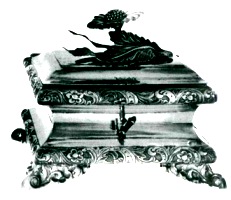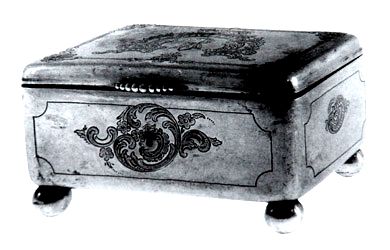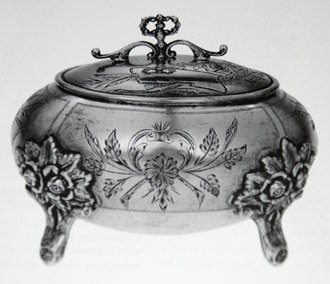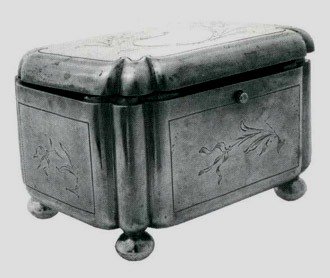by Paulina
Wojdak
(click on photos to enlarge image)
19TH CENTURY SUGAR BOXES IN POLAND
Volumes were written about silver forms in gothic,
renaissance and baroque, but hardly silver collectors
have knowledge and information about Polish silver. The
objective of this article is to familiarize collectors
with 19th century Polish sugar boxes and illustrate
types and varieties of these daily used items.
In Polandís social life of the 19th century sumptuous
dinners were a rare event. More often householders
invited guests for an afternoon tea party, where the
sugar bowl was the most important decoration on the
table.
Generally speaking the Polish 19th century sugar bowl
was a box placed on four legs and just in that shape it
preceded formal transformations that were relative to
period taste and new styles in art.
The box shape became very popular in the 19th century.
It was a different form in comparison with that used in
the previous century, when the most typical were round
and oval sugar bowls.
Around 1800 the most popular sugar container seems to be
a simple box with slightly bulged lid, without any
decorative ornamentation.
|
|
| |
Sugar box of early 19th c., by G.V. Vogtmann
|
|
Sugar box dating from the 1820s, by Tomasz
Klimaszewski
|
The new type of sugar box appeared about 1815, after
Napoleonís wars. It was a box with cut angles, covered
profile lid and lock up with key.
This shape was very popular in the 1820s and 1830s. The
sides and the top (or top and bottom) were decorated
with an ornamental strip of floral motifs.
The profiled lid (and sometimes the front side or the
lateral sides as well) were decorated with plaquettes
cast or sculpted in delicate bas-relief.
The typical ornaments for these plaquettes were floral
motifs, horns of plenty, flower bunches and figural
compositions (allegorical or inspired to the mythology).
|
| |
Sugar box dating from the 1830s, by Karol Filip
Malcz
|
Further modifications took place in the 1840s, when the
"Empire style" changed into historic styles. The shapes of
Polish sugar boxes went in two directions.
A type of "sucrier" was represented by
baroque patterns while another one adopted more modest
shapes.
In the first instance the boxes were characterized by
ostensive, redundant and richly decorated forms.
The distinctive feature was projection on the lid (instead
of earlier plaquettes) of fruits, flowers or animal forms.
These form of sugar boxes was very popular in the next
decade
Sugar box dating from 1860, by Jan Pogorzelski
|
|
| |
Sugar box dating from about 1850, by Emil Radke
|
|
|
A less redundant type of still richly decorated
sugar boxes appeared a little later (in the 50s and
60s). It had concave sides surrounded by heavy
ornamented half-rolls (at the top and bottom) with
figural projections or protruding low relief plaquettes
on the lid.
|
|
Sugar box dating 1853, by Maciej Nowakowski
|
Sugar box dating from about 1860, by Emil Radke
|
A second type of sugar boxes followed a totally opposite
and very simple style. It consisted in modest boxes with
flat lid, straight sides and rounded edges.
The decoration was limited to simple, neo-rococo
engraving. The boxes were supported by four ball-shaped
legs. Characteristic feature was the thumbpiece in the
form of a set of small conjoined balls on the edge of
the lid.
Sometimes a pair of swinging handles was fastened to the
sides. This type was popular in 50s and
60s and in the next two decades evolved to delicately
concave sides or vertical rolls on the corners.
|
|
| |
Sugar box dating from 1860, by Edward Schreider
|
|
|
In the last quarter of the 19th century the Polish sugar
holder evolved to the form of sugar bowl of oval shape.
New solutions were adopted, like discontinuation of
inserting lock in the front, use of solid decorated legs
and lid sunk into the oval body.
Besides the legs, the only decorative motives were
handles protruding on the lid. This form was typical of
the 1880s .
|
|
Sugar bowl dating from 1890s, by Izrael Szekamn
|
|
New changes happened at the end of the 19th century.
We expect that the new "secession style" had huge
influence on the shape of Polish silver boxes, but here
we have two surprises.
First of all art nouveau elements were not popular in
Polish silver - typical secessionist items were produced
in silver plate and tin. Art nouveau in silver appeared
much later (about 1910) and not in the shape of silver
items but as engraved ornaments.
The second surprise was the return of the form dating
from the 1860s in the shape of a modest box with rounded
angles.
These items are identical to the ancient models, the new
form maintain even pearl-like handles. The major
differences were the absence of lock and key replaced by
a latch opened by a button and differently engraved
ornaments.
|
|
| |
Sugar bowl dating 1905-1907, by Piotr Latkowski
|
These were the types of silver sugar bowls dominating in
Poland in the 19th century.
There are some other types absolutely different that canít be
attributed to any of these groups.
They were individual projects or echo of foreign fashion.
|
|
 ASSOCIATION OF SMALL COLLECTORS OF ANTIQUE SILVER
ASSOCIATION OF SMALL COLLECTORS OF ANTIQUE SILVER